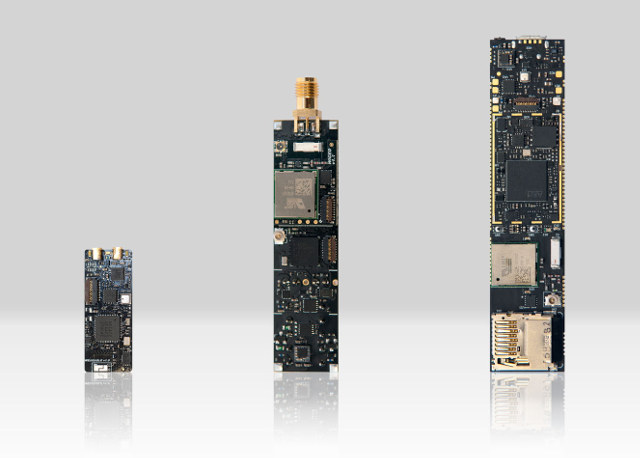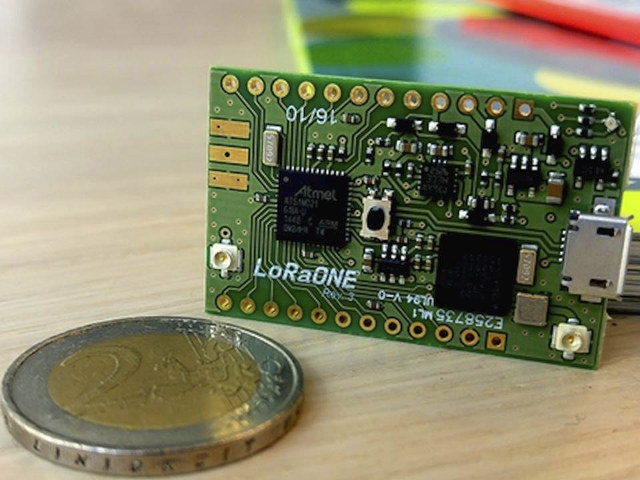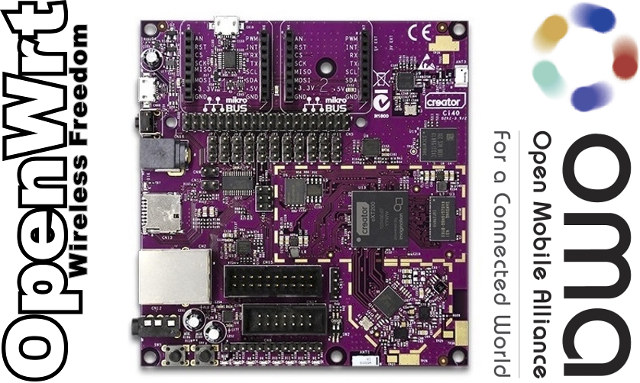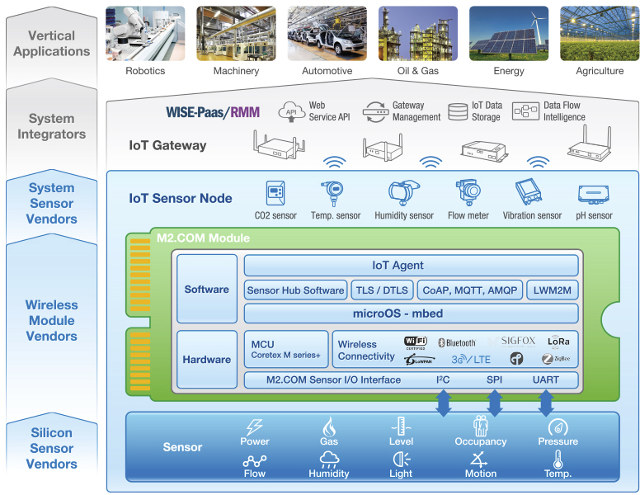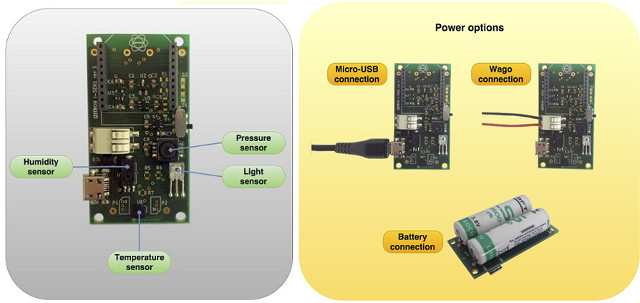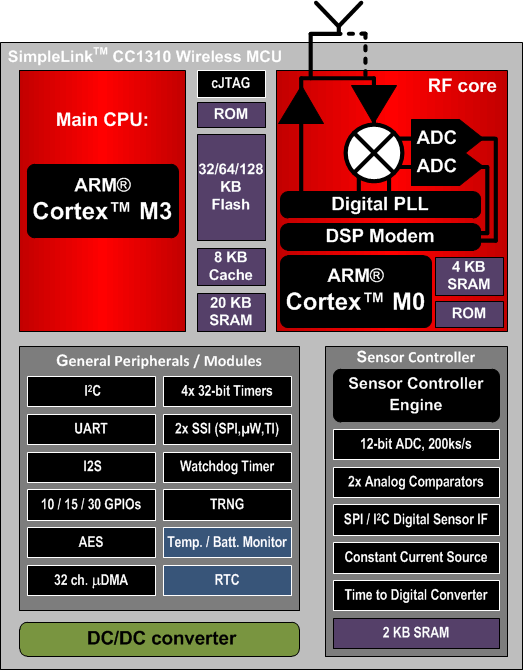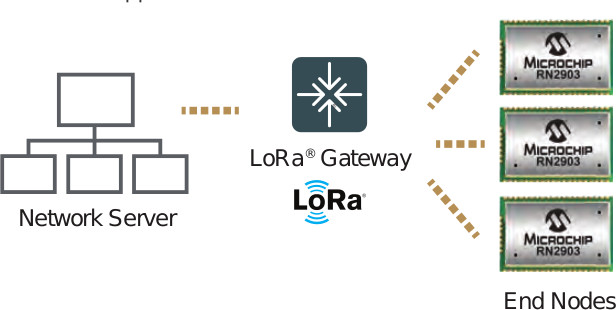LX Group, an Australian company specializing in electronics design and embedded systems, has introduced three wireless modules for IoT and wearables which they call “LX IoT Cores”, and embeds various wireless protocol such as Bluetooth LE/Ant+, 2G/3G connectivity, WiFi, Lora, Sigfox, Taggle, etc… Let’s go though the main technical specs for the three modules, one of which it itself modular (hence the max and min size) depending on your requirements. LX Cellular Core (Right) MCU – STMicro STM32F217IGH6 ARM Cortex-M3 MCU @ 120 MHz with 1MB flash, 128kB RAM Storage – 1x micro SD card reader Communication Interfaces Radios – 2G/3G, WiFi, BLE, ANT+, provision for LoRa, Taggle, SigFox, optional GPS via daughter board Wired – USB, RS485, UART, SPI, I2C, Digital IO, ADC Sensors – Ambient Luminosity, accelerometer, gyroscope, magnetometer, temperature, humidity, air pressure, microphone USB – 1x micro USB port Misc – Reset and 2x user buttons, 2x […]
LoRaONE is a Small LoRa IoT Development Board Based on Atmel SAMD21 MCU, Microchip LoRaWAN Module (Crowdfunding)
While there are many long range LPWAN standards, LoRa appears to be one of the most popular with boards such as LoPy, and now SODAQ LoRaONE module hitting crowdfunding campaigns. LoRaONE is powered by an Atmel Cortex M0+ micro-controller, features Microchip RN2483 or RN2903 LoRaWAN module, GPS, and various sensors. LoRaONE board specifications: MCU- Atmel ATSAMD21G18 ARM Cortex M0+ micro-controller @ 48 MHz with 256 KB flash memory, 32KB SRAM, and up to 16 KB EEPROM (by emulation) Connectivity LoRa via Microchip RN2483 (433/868 MHz) or RN2903 (915 MHz) module depending on your region GPS via u-blox EVA 7M USB – 1x micro USB port for power and programming Expansion headers (unpopulated) 14x digital pin, 12x for analog and 8x for PWM, plus UART, SPI and TWI (I2C) Analog output pin – 10-bit DAC External Interrupts: Available on all pins DC Current per I/O pin: 7 mA Operating Voltage – […]
Imagination Releases OpenWrt and LWM2M Stack Source Code for MIPS Creator Ci40 Development Board
MIPS Creator Ci40 is a development board made by Imagination technology that features the company’s Creator cXT200 “Pistachio” SoC with a dual core MIPS interAptiv processor @ 550MHz and Ensigma C4500 RPU for 802.11ac/ BT 4.1 LE connectivity. The boards are supposed to be shipped to Kickstarter backers in April, but in the meantime, the company has released the source code for OpenWrt distribution as well as LWM2M stack for the board. OpenWRT source code is available in OpenWrt repo in FlowM2M gitbub account. Building the code for MIPS Creator Ci40 is quite straightforward:
|
1 2 3 |
git clone https://github.com/FlowM2M/openwrt cd openwrt make menuconfig |
Select IMG MIPS Pistachio in make menuconfig, save the settings, and then run make to build OpenWrt for the board. This will also build the toolchain, so you don’t need to install any before hand. LWM2M stands for Lightweight Machine to Machine, and is a protocol from the Open Mobile Alliance (OMA) for M2M / […]
M2.COM is a Standard for IoT Sensors Based on M.2 Form Factor
The IoT ecosystem really feels like a jungle now, not because of a lack of standards, but because everybody thinks about doing their own, so we’ve ended up with a wide range of communication protocols, initiatives, and consortia, and it will take some time until the winners and losers are sorted out. One the of the latest standard is M2.COM platform form factor for sensors that “adopts the standardized M.2 form factor and is defined as an evolutionary module that combines general wireless connectivity with additional built-in computing ability powered by MCU”. M2.COM architecture diagram above describes both software and hardware requirements, but the specifications themselves only define the form factor, as well as mechanical and electrical characteristics: Consistent with M.2 standard Module size: 22 mm x 30 mm PCB thickness: 0.8 mm ± 10% Pin count: 75 pins Module input voltage: 3.3V DC-in Connector mating force: 30N Maximum Connector […]
Izitron I-SEN1 Environmental Sensors Board Works with XBee Modules
Izitron, a start-up based in the South of France, has designed a board with temperature, pressure, humidity and light sensors and a XBee header to provide a way to monitoring environmental variables for weather monitoring, agriculture, industrial applications, and more. I-SEN1 technical specifications: Sensors Temperature – Microchip MCP9700-E/T0; accuracy: ±4°C Accuracy from 0°C to +70°C | -4°C/+6°C Accuracy from -40°C to +150°C; temperature range: -40 to 125 °C Pressure – Infineon KP236N6165; accuracy: 2%; pressure range: 60 kPa to 165 kPa; temperature range: -40 to 125 °C Humidity – Honeywell HIH-5030-001; accuracy: ±3% RH; range: 0 to 100% RH; temperature range: -40 to 85 °C Light – AMS TSL14S-LF; reponsivity: 16 mV/ (uW/cm2); temperature range: 0 to 70 °C Header for XBee RF module Power Supply 5V via micro USB 5 to 12V via Wago terminal block 2x batteries No power management chip Power on/off button Power consumption – Up […]
TI SimpleLink CC1310 Wireless MCU Promises 20 Km Range, 20-Year Battery Life on a Coin Cell
Some LPWAN standards such as SigFox, LoRa, or nWave allows for transmission of data at low bitrate over several kilometers, and I’ve very recently featured Microchip’s LoRa modules and motes in this blog. So when Texas Instruments sent their December 2015 newsletter entitled Wireless MCU spans 20 km on a coin cell, I decided to have a look, and the company’s CC1310 wireless Cortex-M3+M0 MCU based on a proprietary sub GHz technology also claims to last 20-year on a coin cell for applications such as grid communication infrastructure and heat and water meters. SimpleLink CC1310 key features: Microcontroller – ARM Cortex-M3 @ up to 48 MHz with up to 128KB programmable flash, 8KB DRAM for cache/general purpose, 20KB Ultralow Leakage SRAM Sensor Controller – Ultralow power and autonomous; 16-Bit Architecture; 2KB of Ultralow Leakage SRAM for code and data RF core Cortex M0 core with 4KB RAM, and ROM Data […]
Microchip Introduces $11 RN2483 & RN2903 LoRa Modules and $70 LoRa Evaluation Kits for IoT & M2M Applications
LoRa is one of those long range low power WAN standards used for the machine to machine (M2M) and Internet of things (IoT) applications. I already featured a Semtech Lora module here with a line-of-sight range of up to 20 to 30km, and the company has just partnered with STMicro to deploy LoRa solutions, but today, I’m going to have a look at Microchip Lora modules and development kits that I discovered in the company’s Micro Solutions Nov/Dec 2015 publication. The company has launched two modules for the European and North American markets with respectively RN2483 LoRa 433/868 MHz R&TTE Directive Assessed Radio Modem and RN2903 915 MHz North American modem. Apart from the different frequencies, both modules have similar features: On-board LoRaWAN Class A protocol stack Tx/Rx Power RN2483 – 40 mA (14dBm, 868MHz) Tx, and 14.2 mA Rx @ 3.6V RN2903 – 124 mA Tx max, and 13.5 mA […]
ARM TechCon 2015 Schedule – IoT, Servers, 64-bit ARM, Power Usage Optimization, and More
The ARM Technology Conference (ARM TechCon) will take place on November 10 – 12, 2015, in Santa Clara Convention Center, and just like every year, there will be a free exposition for companies to showcase their latest innovation and/or products, as well as a technical conference with sessions and workshops sorted into various tracks: Automotive/Embedded Vision Embedded IoT Mobile/Connectivity Networking Infrastructure/Servers Tools & Implementation Wearables/Sensors ARM Training Day Sponsored Vendor Training Special Event General Event Software Developers Workshop You can find the complete schedule on ARM TechCon website. Although I won’t attend, I’ve created my own virtual schedule with some of the sessions I found interesting. Tuesday – November 10 8:30 – 9:20 – ARM Vision for Thermal Management and Energy Aware Scheduling on Linux by Ian Rickards (ARM), Charles Garcia-Tobin (ARM), Bobby Batacharia (ARM) This talk will cover the history and where are we going, for ARM’s Power Software (IPA, […]


